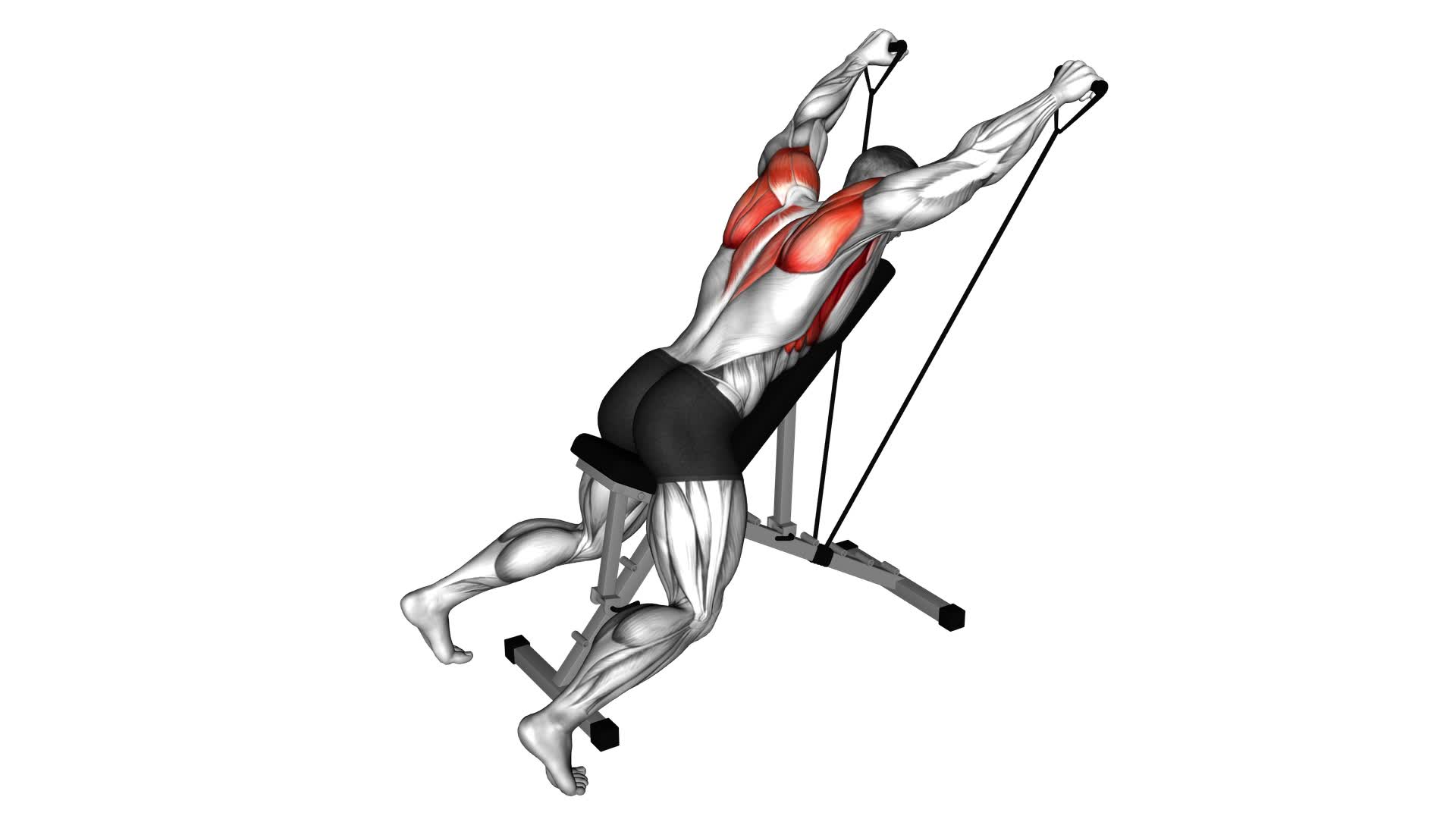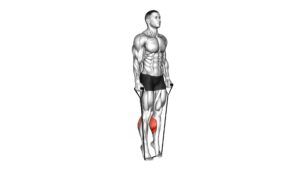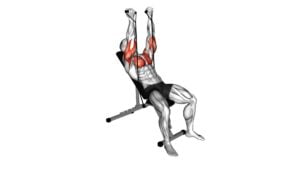Band Incline Y Raise – Video Exercise Guide & Tips

Are you looking for a challenging exercise to strengthen your upper body? Look no further than the Band Incline Y Raise!
Watch This Exercise Video
This video exercise guide and tips article will show you how to properly perform the Band Incline Y Raise for maximum results. With just a resistance band and a bench, you can target your shoulders and upper back muscles effectively.
Avoid common mistakes and get ready to see improvements in your upper body strength with this powerful exercise.
Key Takeaways
- The Band Incline Y Raise targets muscles in the upper back, shoulders, and arms.
- It improves posture and strengthens the upper body.
- The exercise enhances shoulder stability and mobility.
- It helps prevent shoulder injuries and improves overall upper body strength.
Benefits of the Band Incline Y Raise
Discover the numerous benefits of incorporating the Band Incline Y Raise into your workout routine. This exercise targets the muscles in your upper back, shoulders, and arms, helping to improve your posture and strengthen your upper body.
One of the key benefits of the Band Incline Y Raise is that it can be easily modified to suit your fitness level and goals. By varying the resistance of the band or adjusting the incline of the bench, you can increase or decrease the difficulty of the exercise. This makes it suitable for beginners and advanced fitness enthusiasts alike.
Additionally, the Band Incline Y Raise helps to improve shoulder stability and mobility, which can be beneficial for athletes and individuals who engage in activities that require overhead movements. Incorporating this exercise into your routine can also help to prevent shoulder injuries and improve your overall upper body strength.
Equipment Needed for the Exercise
To perform the Band Incline Y Raise, you'll need a resistance band and an incline bench. Here are the essential equipment and considerations for this exercise:
- Resistance Bands: There are different types of resistance bands available in the market. You can choose from loop bands, tube bands, or figure-eight bands. The resistance level will vary depending on the color or thickness of the band. Select a band that provides enough resistance to challenge your muscles without causing strain.
- Incline Bench: An incline bench is necessary to perform the Band Incline Y Raise correctly. Make sure the bench is stable and at a comfortable angle. It should support your back and shoulders adequately.
- Anchor Point: To perform this exercise, you need a secure anchor point to attach the resistance band. This can be a sturdy object like a door frame, pole, or a wall-mounted anchor specifically designed for resistance bands.
- Alternative Exercises: If you don't have access to an incline bench, you can modify the exercise by performing the Y Raise in a standing position with your feet hip-width apart. Alternatively, you can use dumbbells or kettlebells instead of resistance bands to target the same muscle groups.
Remember to choose the appropriate resistance band and ensure a stable anchor point to perform the Band Incline Y Raise safely and effectively.
Step-By-Step Guide to Performing the Band Incline Y Raise
Now let's move on to the step-by-step guide for performing the Band Incline Y Raise. This exercise targets the muscles in your upper back and shoulders, specifically the rear deltoids.
To begin, set up an incline bench at a 45-degree angle and place a resistance band around the legs of the bench. Grab the band with an overhand grip, with your palms facing down and your arms extended in front of you.
Lean forward and keep your back flat against the bench. This is your starting position.
Now, raise your arms out to the sides, forming a Y shape with your body. Be sure to keep your elbows slightly bent and maintain control throughout the movement.
Slowly lower your arms back to the starting position and repeat for the desired number of repetitions.
To vary the exercise, you can use different resistance bands to adjust the intensity or try performing the Y raise with dumbbells instead of a resistance band.
Remember to always use proper form and start with a weight or resistance level that challenges you but still allows you to maintain good technique.
Common Mistakes to Avoid During the Exercise
When performing the Band Incline Y Raise, it's important to be aware of common mistakes to avoid during the exercise. By avoiding these mistakes, you can prevent injuries and ensure that you're using proper form throughout the movement.
Here are four common mistakes to watch out for:
- Using too much momentum: It's important to perform the exercise in a slow and controlled manner, rather than relying on momentum to lift the bands. This will ensure that you're targeting the correct muscles and reducing the risk of injury.
- Arching your back: Maintaining a neutral spine is crucial during the Band Incline Y Raise. Avoid arching your back or allowing your lower back to lift off the bench, as this can put unnecessary strain on your spine.
- Shrugging your shoulders: Keep your shoulders relaxed and down throughout the exercise. Avoid shrugging or lifting your shoulders towards your ears, as this can lead to tension and discomfort in the neck and upper back.
- Overextending your arms: While it's important to fully extend your arms during the movement, avoid hyperextending your elbows. Be mindful of keeping a slight bend in your elbows to avoid putting excessive stress on the joint.
Tips for Maximizing Your Results With the Band Incline Y Raise
To maximize your results with the Band Incline Y Raise, focus on proper technique and gradually increase the resistance of the bands. This exercise primarily targets the muscles in your shoulders and upper back, but with a few modifications, you can tailor it to different fitness levels and target specific muscle groups.
For beginners or those with limited upper body strength, start by using a lighter resistance band. This will allow you to focus on mastering the proper form and gradually build strength over time. As you become more comfortable, you can increase the resistance by using a thicker band or adding more bands.
To target specific muscle groups, you can modify the Band Incline Y Raise. For example, to engage your rear deltoids, perform the exercise with your thumbs pointing down instead of up. This slight change in hand position will shift the focus to your rear delts.
Alternatively, to target your traps and rhomboids, you can perform the exercise with your palms facing each other instead of facing down. This variation will engage these muscles more intensely.
Remember to always maintain a neutral spine and engage your core throughout the exercise. By modifying the Band Incline Y Raise for different fitness levels and targeting specific muscle groups, you can maximize your results and achieve a well-rounded upper body workout.
Frequently Asked Questions
How Many Sets and Reps Should I Do for the Band Incline Y Raise?
To determine how many sets and reps you should do for the band incline Y raise, it's important to focus on the exercise's benefits and variations.
This exercise primarily targets your upper back and shoulders, helping to improve posture and strengthen those muscles.
As for the sets and reps, it's generally recommended to start with 2-3 sets of 10-12 reps. However, you can adjust the numbers based on your fitness level and goals.
Can I Use Dumbbells Instead of Resistance Bands for This Exercise?
Yes, you can use dumbbells instead of resistance bands for the Band Incline Y Raise exercise. Dumbbells can provide a similar level of resistance and target the same muscles.
However, it's important to note that resistance bands offer unique benefits such as constant tension throughout the movement and the ability to target smaller stabilizer muscles.
Is the Band Incline Y Raise Suitable for Beginners?
The Band Incline Y Raise is a great exercise for beginners looking to strengthen their shoulders and upper back. It targets the posterior deltoids and helps improve posture.
To modify, use lighter resistance bands or decrease the incline. Avoid common mistakes like using momentum or lifting too high. Remember to engage your core and keep your back straight throughout the movement.
This exercise offers numerous benefits and can be easily modified for beginners.
How Long Should I Rest Between Sets During This Exercise?
When doing the band incline Y raise, it's important to give yourself enough rest between sets to recover and maintain proper form. The rest duration can vary depending on your fitness level and goals.
Generally, a rest period of around 1-2 minutes is recommended. However, if you're looking to increase the intensity, you can decrease the rest time to challenge your muscles even more.
Remember to listen to your body and adjust the rest duration accordingly.
Can I Incorporate the Band Incline Y Raise Into a Full-Body Workout Routine?
Yes, you can definitely incorporate the band incline Y raise into a full-body workout routine. It offers several benefits such as targeting multiple muscle groups including the shoulders, upper back, and arms.
Additionally, it helps improve posture and stability.
To vary the workout and target different muscle groups, you can try different variations of the band incline Y raise such as using different resistance bands or adjusting the incline angle.
Conclusion
In conclusion, the Band Incline Y Raise is an effective exercise that targets the muscles in your shoulders and upper back. By using resistance bands and an incline bench, you can easily perform this exercise at home or in the gym.
Remember to follow the step-by-step guide and avoid common mistakes to maximize your results. Incorporating the Band Incline Y Raise into your workout routine can help improve your posture and strengthen your upper body.

Author
Years ago, the spark of my life’s passion ignited in my mind the moment I stepped into the local gym for the first time. The inaugural bead of perspiration, the initial endeavor, the very first surge of endorphins, and a sense of pride that washed over me post-workout marked the beginning of my deep-seated interest in strength sports, fitness, and sports nutrition. This very curiosity blossomed rapidly into a profound fascination, propelling me to earn a Master’s degree in Physical Education from the Academy of Physical Education in Krakow, followed by a Sports Manager diploma from the Jagiellonian University. My journey of growth led me to gain more specialized qualifications, such as being a certified personal trainer with a focus on sports dietetics, a lifeguard, and an instructor for wellness and corrective gymnastics. Theoretical knowledge paired seamlessly with practical experience, reinforcing my belief that the transformation of individuals under my guidance was also a reflection of my personal growth. This belief holds true even today. Each day, I strive to push the boundaries and explore new realms. These realms gently elevate me to greater heights. The unique combination of passion for my field and the continuous quest for growth fuels my drive to break new ground.



